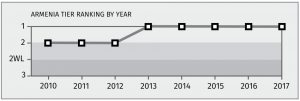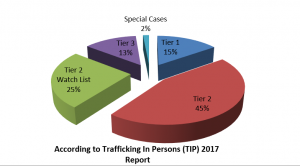The analysis of Trafficking in Persons Report (2017) with the successful example of Armenia
Human trafficking is one of the most profitable crimes of the world. Trafficking in persons is a serious crime and a grave violation of human rights. Every year, thousands of men, women and children fall into the traffickers’ hands, in their own countries and abroad.
The main types of human trafficking are:
- sexual exploitation
- forced labor
- child trafficking
- sale of organs
Three preconditions are required for a case of trafficking qualification:
- action (recruitment, movement, transferring, hiding, receiving)
- measures (violence, threat, coercion, kidnapping, fraud, abuse of trust, use of vulnerability)
- purpose of exploitation (sexual, forced labor, enslavement, removal of organ)
All of above-mentioned actions are implemented by traffickers who can personally know or not even know the victim.
According to the RA Police statistics, there were even cases when traffickers were relatives or friends of the victims, sometimes even the initiators were parents. Traffickers mislead the victims with promises and guarantees of profitable work in homeland or abroad. The promises are from earning high profits for non-professional job to starting or continuing professional career in a well-known international organization.
Trafficking is a transnational organized crime against which we must fight jointly. Since 2001, US Department of State has annually published TIP (Trafficking in person) report which includes comprehensive information about actions carried out by the governments involved countries: victim support, protection, prevention, awareness, prosecution and recommendations to improve the results for combatting against trafficking.
The 2017 Report focuses particularly on increasing the responsibility of 178 countries’ governments to bring the criminals to justice and prevent human trafficking around the world.
The Report is also intended to help governments investigating cases and law enforcement bodies take appropriate actions. The 2017 TIP (Trafficking in persons) report mostly focuses on criminal responsibility of traffickers with the 3P paradigm: persecution, protection and prevention.
There are 3 types of countries from trafficking perspective:
- source country (from where potential victims are recruited)
- transit country ( through where the victims are transported)
- destination (where the main exploitation of victims are carried out)
According to above-mentioned Report Armenia is source and destination country for men, women and children subjected to labor and sexual trafficking.
There are the follows countries according to TIP Report.
Tier 3: Countries whose governments do not fully meet the Trafficking Victims Protection Act’s minimum standards and are not making significant efforts to do so. In 2017, Russia, Uzbekistan, Turkmenistan, Belarus, Iran and 18 more countries are included in this list.
Tier 2 Watch List (WL): Countries whose governments do not fully meet the TVPA’s minimum standards, but are making significant efforts to bring themselves into compliance with those standards and:
a) the absolute number of victims of severe forms of trafficking is very significant or is significantly increasing;
b) there is a failure to provide evidence of increasing efforts to combat severe forms of trafficking in persons from the previous year; or
c) the determination that a country is making significant efforts to bring itself into compliance with minimum standards was based on commitments by the country to take additional future steps over the next year.
Bulgaria, Hungary, Moldova, Serbia, Iraq, Saudi Arabia and 38 more countries are included in this list according to 2017 TIP report.
Tier 2: Countries whose governments do not fully meet the TVPA’s minimum standards, but are making significant efforts to bring themselves into compliance with those standards. Azerbaijan, Turkey, United Arab Emirates, Kazakhstan, Kyrgyz Republic and 75 more countries are included in this list in 2017 TIP Report.
Tier 1: The governments of countries that fully meet the TVPA’s minimum standards for the elimination of trafficking. There are taken measures of prevention, awareness, protection and the results are visible. Armenia, Georgia and 25 other countries are included in this list of 2017 TIP Report.

There is also “Special Cases” list in which the situation about this topic is more complicated. In 2017 TIP Report there are 3 countries involved in this list: Libya, Somalia, Yemen .
If we analyze 2017 TIP report, we can state that only 15 % of involved countries are included in Tier 1 list, and the highest 45% is Tier 2 list. Armenia, fifth year constantly, is on Tier 1 group (since 2013). This means that the government of Republic of Armenia fully meets the Trafficking Victims Protection Act’s (TVPA) minimum standards.

According to the above mentioned Report 14,897 prosecution were registered in 2016, compared to 18,930 in 2015, where we can note that the prosecutions in 2016 were 4033 less than in 2015.
In 2016, 66,520 victims of trafficking were identified around the world compared to 77,823, victims in 2015. The number of victims found in 2016 has dropped by 11,303 compared to the previous year.
According to the above-mentioned report 600-800 thousand people become trafficking victims each year in interstate borders and 80 % of which are women and children.
The government of RA investigated 16 trafficking cases, compared to 14 in 2015; of these, five cases were sex trafficking, 10 cases were labor trafficking, and one case was both sex and labor trafficking, compared to four labor trafficking cases and 10 sex trafficking cases investigated in 2015. Authorities prosecuted one defendant, compared to two in 2015. Courts convicted three sex traffickers, the same as in 2015. Two traffickers received sentences of eight years imprisonment and one received five years imprisonment. Prosecution of labor trafficking remained a challenge as many cases occurred in Russia, where Armenian investigators continued to face difficulties collaborating with law enforcement. Similarly, the absence of diplomatic relations with Turkey continued to hinder law enforcement and victim protection efforts for cases involving that country.
According to TIP 2017 Report RA government maintained protection efforts. The government identified 22 victims, compared to nine in 2015. Nineteen were subjected to forced labor and three to sex trafficking. Authorities notified all victims of their right to services and 19 victims accepted NGO-run shelter assistance, compared to five in 2015. Armenia is one of the countries in former Soviet Union that state budget provides money for combatting against trafficking and assistance to victims.
In 2016 the RA government allocated 18.8 million drams ($39,260) for victim protection efforts, including operational costs for an NGO-run shelter, compared to 18.3 million drams ($38,100) in 2015.
The Law on Identification and Assistance to Victims of Human Trafficking and Exploitation ensures victim assistance which is not linked to their cooperation with law enforcement and affords foreign trafficking victims the same rights and services as Armenian citizens.
The government and local NGOs jointly provided victims legal, medical, and psychological assistance: housing and access to social, educational, and employment projects. The government has offered free health care; one victim received this service in the TIP 2017 reporting period. The government maintained cooperation agreements with two specialized NGO-run shelters to provide services to victims; however, one NGO-run shelter closed at the end of February 2017 due to the completion of their donor-funded project. Services were available to female and male victims. Shelters did not provide specialized services for child victims, who could be housed in an adult trafficking shelter or referred to a child care institution. NGOs reported law enforcement officers in remote areas lacked information and training to inform victims of their rights to protection or assistance. As a result of a legal change suspending most Labor Inspectorate functions in July 2015, inspectors were unable to conduct regular inspections and identify indications of forced labor. The law designates the Ministry of Foreign Affairs to coordinate repatriation of Armenian trafficking victims from abroad; however, observers reported difficulties in such repatriations due to a lack of established procedures and funds to cover logistical costs. The government, in cooperation with NGOs, repatriated 11 labor trafficking victims from Russia through ad hoc procedures and funds from different sources including government, NGOs, and churches.

In TIP 2017 Report there are also recommendations for Armenia which includes the following.
‘’Vigorously investigate, prosecute, and convict traffickers proactively investigate all potential trafficking offenses, even those complaints filed by victims that do not specifically mention trafficking; improve efforts to identify victims of forced labor, including by strengthening victim identification training for officials; allow labor inspectors to conduct regular inspections and identify victims through unannounced visits; establish formal procedures for repatriating trafficking victims from abroad, including measures to cover logistical costs; maintain adequate funding for NGO-run shelters; train rural police officers on protection and assistance available to victims and local investigators on proper interviewing techniques, especially for children; work with Russian authorities to identify Armenian forced labor victims and prosecute labor traffickers; work with NGOs to find ways to identify and assist Armenian victims in Turkey and reintegrate victims; provide sensitivity training to judges and lawyers to improve treatment of victims; license, regulate, and educate local employment agencies and agents so they can help prevent the forced labor of Armenians abroad; approve legislation to establish victim-witness protection measures; and conduct awareness-raising campaigns to rural and border communities and to children leaving child care institutions.’’
According to RA Police, the main target country for labor trafficking from Armenia is Russia. The UAE and Turkey are the target countries for sexual exploitation of RA citizens.
In Armenian rural areas men with low levels of education and children from social care institutions are extremely vulnerable to human trafficking. Each year the steps for combating trafficking increase as well as operative actions are taken to detect such cases.
According to the official data of the RA police, Armenia actively cooperates with Russia and the UAE. The cooperation with law enforcement agencies is implemented by Interpol and in case of UAE sometimes through the Embassy of Armenia. Armenia does not have diplomatic relations with Turkey, the absence of which creates visible obstacles for search and detection of preventive measures.
Since 2007, the Council on Human Trafficking in Armenia has existed. The staff and procedure of the council is approved by the Prime Minister of RA. The council is composed of president, members and secretary who participate in council activities through a voluntary basis. The Council organizes its work through sessions, which are convened by the President of the Council. The Working Group (WG) has been established and operates to organize the current work of the Council. The Working Group develops afterwards Council approves the National Program on Combating human trafficking in Persons in RA, according to which the fight against human trafficking in Armenia has started in 2002.
The Government of Armenia has approved the concept of preventing illegal transportation and buying/selling people for exploitation (trafficking) from RA.
Four national programs have already been adopted and implemented. The 2016-2018 national program is in implementation process.
Being in the first group and establishing there strong position for 5 years has been the result of consistent struggle but this circumstance should never weaken the vigilance of governmental and non-governmental structures in the fight against trafficking.
Analyze by Gayane Hayrapetyan

About the author